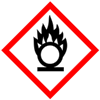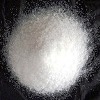| Anmol Chemicals is the pioneer manufacturers of Sodium Bromate, Pharmaceutical Excipients Fragrance Food & Flavor chemicals in India. We offer Halal and Kosher Sodium Bromate made in an ISO9001, ISO22000 (FSSC22000) cGMP and GLP certified facility. Our group has several manufacturing facilities spread across the world, supported by toll manufacturers and representatives in UAE, Europe, Africa, USA, China and has several associated manufacturing facilities spread across India. All the Information on Physics, Chemistry, Applications, Uses and Technology on Manufacture of Sodium Bromate is in these pages. |
| The units have one or more of the certifications like FDA GMP, ISO 9001, ISO 22000, HACCP, REACH, Kosher & Halal |
Sodium Bromate SDS MSDS Sheet of Manufacturers, NaBrO3
Specifications of Sodium Bromate Manufacturers
Sodium Bromate SDS, Safety Data Sheet
1. Product Identification
Product: Sodium Bromate.
CAS No.: 7789-38-0
EINECS: EC Number: 232-160-4
2. Hazards Identification
GHS, Globally Harmonized System Classification in accordance with 29 CFR 1910
Classification according to Regulation (EC) No 1272/2008:
Oxidizing solids Category 3
Acute Toxicity Oral Category 4
Skin irritation Category 2
Eye irritation Category 2A
Specific target organ toxicity - single exposure Category 3, Respiratory system
Labeling according to GHS & Regulation (EC) No 1272/2008
GHS Label Elements  Oxidizing Solid |
GHS Label Elements  Irritant |
Signal Word: Warning
Hazard Statements:
H272: May intensify fire; oxidizer.
H302: Harmful if swallowed.
H315: Causes skin irritation.
H319: Causes serious eye irritation.
H335: May cause respiratory irritation.
Precautionary Statements
P210: Keep away from heat/sparks/open flames/hot surfaces – No smoking.
P220: Keep/Store away from clothing/…/combustible materials.
P221: Take any precaution to avoid mixing with combustibles.
P260: Do not breathe dust/fume/gas/mist/vapors/spray.
P264 Wash thoroughly after handling.
P270 Do not eat, drink or smoke when using this product.
P273: Avoid release to the environment.
P280 Wear protective gloves/protective clothing/eye protection/face protection.
P330: Rinse mouth.
P301+P312: IF SWALLOWED: Call a POISON CENTER or doctor/physician if you feel unwell.
P301+P330+P331 IF SWALLOWED: rinse mouth. Do NOT induce vomiting.
P302+P352: IF ON SKIN: Wash with soap and water.
P303+P361+P353 IF ON SKIN (or hair): Remove/Take off immediately all contaminated clothing. Rinse skin with water/shower.
P304+P340 IF INHALED: Remove victim to fresh air and keep at rest in a position comfortable for breathing.
P305+P351+P338: IF IN EYES: Rinse cautiously with water for several minutes. Remove contact lenses, if present and easy to do. Continue rinsing.
P310 Immediately call a POISON CENTER or doctor/physician.
P332+P313: If skin irritation occurs: Get medical advice/attention.
P337+P313 If eye irritation persists: Get medical advice/ attention.
P342+P311 If experiencing respiratory symptoms: Call a POISON CENTER or doctor/physician.
P370+P378: In case of fire: Use … for extinction.
P362: Take off contaminated clothing and wash before reuse.
P501 Dispose of contents/container in accordance with local/regional/national/international regulations.
3. Composition/Information on Ingredients
Product: Sodium Bromate.
CAS No.: 7789-38-0
4. First Aid Measures
Always seek medical attention after first aid measures are provided.
Inhalation: Remove to fresh air. If not breathing, give artificial respiration. If breathing is difficult, give oxygen. Get medical attention.
Ingestion: Never give anything by mouth to an unconscious person. Get medical attention.
Skin Contact: Wipe off excess material from skin then immediately flush skin with plenty of water for at least 15 minutes. Remove contaminated clothing and shoes. Get medical attention. Wash clothing before reuse. Thoroughly clean shoes before reuse.
Eye Contact: Immediately flush eyes with plenty of water for at least 15 minutes, lifting lower and upper eyelids occasionally. Get medical attention immediately.
5. Fire Fighting Measures
Flammability of the Product: The product is not flammable but it is an oxidizer.
Products of Combustion: It emits toxic oxides of sodium and hydrogen bromide or bromine.
Fire: It is an oxidizer.
Fire Extinguishing Media: Use water spray, alcohol-resistant foam, dry chemical or carbon dioxide. Use means suitable for extinguishing surrounding fire.
Special Information In the event of a fire, wear full protective clothing and NIOSH-approved self-contained breathing apparatus with full face piece operated in the pressure demand or other positive pressure mode. Use water spray to cool unopened containers.
6. Accidental Release Measures
Small Spill: Avoid dust formation. Avoid breathing dust. Ensure adequate ventilation. Use appropriate tools to put the spilled solid in a convenient waste disposal container. Finish cleaning by spreading water on the contaminated surface and dispose of according to local and regional authority requirements.
Large Spill: Do not let the product enter drains. Use a shovel to put the material into a convenient waste disposal container.
7. Handling and Storage
Do not breathe dust. Wear suitable protective clothing. In case of insufficient ventilation, wear suitable respiratory equipment.
Avoid contact with skin and eyes. Avoid formation of dust and aerosols. Wash hands thoroughly after handling. Provide appropriate exhaust ventilation at places where dust is formed. If you feel unwell, seek medical attention.
Keep in a tightly closed container, stored in a cool, dry, ventilated area. Protect against physical damage or contact with oxidizing material and combustible substances.
8. Exposure Controls/Personal Protection
Airborne Exposure Limits: None established.
Ventilation System: A system of local and/or general exhaust is recommended to keep employee exposures as low as possible. Local exhaust ventilation is generally preferred because it can control the emissions of the contaminant at its source, preventing dispersion of it into the general work area.
Personal Respirators (NIOSH Approved): For conditions of use where exposure to dust or mist is apparent and engineering controls are not feasible, a particulate respirator may be worn. For emergencies or instances where the exposure levels are not known, use a full-face positive-pressure, air-supplied respirator.
9. Physical and Chemical Properties
Appearance: It is colorless or white crystals or powder or granules.
Odor: None to slight.
Solubility: Readily soluble in water
pH: 5-9 at 5% solution at 25 C (77F)
Density: 3.34 gm/cc
Molecular Weight: 150.89
Chemical Formula: NaBrO3
% Volatiles by volume @ 21C (70F): 0
Boiling Point: Decomposes.
Melting Point: NA
10. Stability and Reactivity
Stability: It is stable under ordinary conditions of use and storage.
Hazardous Decomposition Products: It emits toxic hydrogen bromide or bromine along with sodium oxide when heated to decomposition.
Hazardous Polymerization: Will not occur.
Incompatibilities: Strong reducing agents, Powdered metals, Alcohols, Strong acids.
Conditions to Avoid: Moisture, Heat, Incompatibles.
11. Toxicological Information
Toxicity to Animals:
LD50 Intraperitoneal - mouse - 140 mg/kg
Carcinogenicity: This product present at levels greater than or equal to 0.1% is identified as probable, possible or confirmed human carcinogen by IARC, NTP, ACGIH & OSHA.
12. Ecological Information
Environmental Toxicity: Not available.
Toxic to aquatic organisms, may cause long-term adverse effects in the aquatic environment. Do not empty into drains. Do not flush into surface water or sanitary sewer system. Do not allow material to contaminate ground water system.
13. Disposal Considerations
Whatever cannot be saved for recovery or recycling should be managed in an appropriate and approved waste disposal facility. Processing, use or contamination of this product may change the waste management options. State and local disposal regulations may differ from federal disposal regulations. Dispose of container and unused contents in accordance with federal, state and local requirements. Small amounts of this material may be suitable for sanitary sewer or trash disposal.
14. Transport Information
DOT (USA) & ADR/RID
UN-Number: UN1494 Class: 5.1 Packing group: II
Proper shipping name: Sodium bromate
IMDG
UN-Number: UN1494 Class: 5.1 Packing group: II
Proper shipping name: Sodium bromate
IATA
UN-Number: UN1494 Class: 5.1 Packing group: II
Proper shipping name: Sodium bromate
15. Regulatory Information
USA:
OSHA Hazards: Harmful by ingestion, Oxidizer.
SARA 302 Components: SARA 302: No chemicals in this material are subject to the reporting requirements of SARA Title III, Section 302.
SARA 313 Components: SARA 313: This material does not contain any chemical components with known CAS numbers that exceed the threshold (De Minimis) reporting levels established by SARA Title III, Section 313.
SARA 311/312 Hazards: Reactivity Hazard, Acute Health Hazard, Chronic Health Hazard
California Prop 65: This product does not contain any chemicals known to State of California to cause cancer, birth defects, or any other reproductive harm.
Canada - DSL/NDSL: CAS# 7789-38-0 is listed on Canada's DSL List.
Canadian WHMIS Classifications: C Oxidizing materials, D2B Toxic materials
Section 16 - Additional Information
Disclaimer:**************************
Our company provides this SDS MSDS sheet in good faith but makes no representation as to its comprehensiveness or accuracy. This SDS sheet is intended only as a guide to the appropriate precautionary handling of the material by a properly trained person using this product. The above information has been compiled from various sources and has the possibility of discrepancy and being out-dated information. Individuals receiving the information must exercise their independent judgment and do further search in determining its appropriateness for a particular purpose. In no case shall our company be liable to loss or damages by the product user.
**************************
Sodium Bromate manufacturers at:
Anmol Chemicals
S-8, SARIFA MANSION, 2ND FLANK ROAD, CHINCHBUNDER, MUMBAI 400009, INDIA
TEL: (OFFICE) 91-22-23770100, 23726950, 23774610, 23723564 - FAX: 91-22-23728264
e-mail: anmolc@mtnl.net.in

Ammonium persulfate -- Calcium saccharate -- Ceric ammonium nitrate -- Cupric chloride -- Calcium Hydroxide -- Sodium formaldehyde bisulfite -- Isatoic anhydride -- Sodium bromide -- Sodium citrate --
Exports to USA, Canada, UAE, Dubai, South Africa, Tanzania, Kenya, Nigeria, Egypt, Uganda, Turkey, Mexico, Brazil, Chile, Argentina, Europe Netherlands, Italy, Spain, Germany, Portugal, France, Malaysia, Indonesia, Thailand, Ukraine, Korea, Japan, etc.
Copyright and Usual Disclaimer is Applicable. 12 February, 2022



